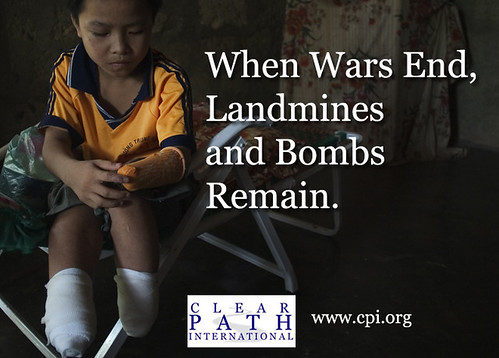
Pollution. Consider for a moment what the word means. If it's defined as "the presence in the environment of any substance of sufficient concentration to be harmful to humans or cause long-term damage to the natural environment," landmines fit the bill.
In fact, some consider landmines as the most toxic and widespread pollution in the world. It's important to remember that even as we mark the 10th anniversary of the signing of the Ottawa Convention on Dec. 3 this year.
I made those points during a presentation Sunday at the 5th Annual Western Regional International Health Conference at the University of Washington campus. The conference is a brainchild of the Puget Sound Partners in Global Health, which include the Bill & Melinda Gates Foundation, Fred Hutchinson Cancer Research Center, PATH, UW School of Medicine, UW School of Public Health & Community Medicine, Seattle Biomedical Research Institute and others.
Puget Sound Partners for Global Health (www.pspgh.org) is a collaboration of Seattle-area researchers, healthcare professionals, students and non-governmental organizations committed to improving global health. It links the Seattle global health community by sharing information; funding international training, education and research opportunities; and holding events focused on global health.
I was invited to speak on the health and development problems caused by landmines. They are numerous. But before I get into that, let's look at some global statistics:
The world has roughly 110 million landmines spread among 80 countries, mostly in the developing world. More than 140 million people live in areas where their lives or livelihoods are threatened by landmines or unexploded ordnance (UXO).
About 20,000 to 30,000 people are killed or injured by mines each year with as many as two out of every three victims being civilians and one in every four being children.
Of course, the number of casualties and the burden of the treatment on already challenged health care systems in the Third World is just that part of the landmine problem that sticks up above the surface.
Let's go back to the notion of landmines as pollution. That breaks down into two parts: the danger and the damage. The danger obviously comes from the threat they cause to life, causing people to alter their behavior.
One big problem in places like Africa is that the presence or even the fear of landmines means local villagers avoid getting their drinking water from sources that are relatively clean and get them from polluted rivers instead. Add to that the danger of collecting firewood in mined areas and they do not even boil the water for consumption.
This leads to serious health conditions such as diarrhoeal diseases. Another one is malnutrition caused by the presence of mines and UXO in areas that could otherwise yield food crops.
In Libya, heavily mined during World War II, two thirds of the arable land is confirmed or suspected of being contaminated. Locally, they are known as "fields of the devil" and have killed 125,000 sheep, goats, cattle and camels since the 1940s, further reducing their use as a source of food.
In Afghanistan, already anemic in its ability to produce food crops, 20 percent of all farm land was taken out of circulation by landmines and UXO. Farm output is still only at 45 percent of prewar levels.
The damage landmines cause comes from the explosions and the chemicals inside them. Detonations destroy the top soil. In the former DMZ districts of Gio Linh and Vinh Linh, central Vietnam, a 50 percent drop in the rice production per hectare has been blamed on regular explosions from ordnance left by years of warfare.
Even lurking quietly on or under the surface, landmine and UXO affect the soil. Their poisonous insides containing TNT, RDX & cyclonites or tetryl leach out and soluble in water, causing toxicity to humans and mammals even in small quantities.
But the nightmare doesn't end there. During conflicts, mines are typically placed near roads, airfields, bridges, power stations, irrigation systems and other elements of a country's infrastructure.
This means that in peacetime such places are equally inaccessible to aid workers providing food supplies to refugees or villagers, immunization or foods rich in iodine lacking in many communities. Entire vaccination campaigns in Angola and Zambia were called off because public health workers found antitank mines on their routes. Health experts have pointed to a correlation between mined communities and the recurrence of polio.
And the presence or fear of mines causes problems in areas that are considered safe, such as crowded living conditions, sanitation breakdowns and a burden on existing services, further leading to the health crisis posed by the other conditions already mentioned.
I haven't even touched on the ripple effects of landmine injuries themselves, such as the spread of HIV infection through the regular need of blood transfusions among amputees in hospital with poor quality controls on their donated blood supplies; or the indirect effects of survivors' post-traumatic stress syndrome on their families, such as substance abuse and domestic violence -- not to mention the high rate of unemployment among persons with disabilities in mine-affected communities.
These observations concluded the first part of my presentation at the conference. In the second part, I focused on the solutions, some of which are provided by Clear Path and other humanitarian mine action organizations. More about that in Part 2.
No comments:
Post a Comment